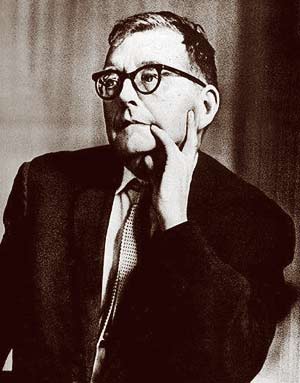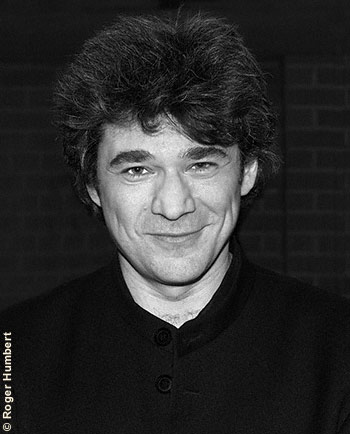|
|
Shostakovich: A Centenary Celebration
Presented by Art of Time Ensemble |
|
| March 24 & 25, 2006 • Harbourfront Centre Theatre • Toronto |
|
|
|
|
|
|

DSCH
by Joyce Corbett with photo of Andrew Burashko by Roger Humbert |
|
The only light in the theatre falls on two guitarists seated in the side balcony overhanging the stage. A classical duet, exquisitely executed, captivates the audience sitting in the dark below.
After the applause, Ross Petty assures us that yes, we are in the right place and yes, this is the music of Dmitri Shostakovich (this duet was not on our printed programs). Eloquently, he reads the words of artistic director and pianist Andrew Burashko, informing us that this evening’s program was created to present us with a fuller view of Shostakovich — the man and his music. The guitar duet we had just heard was part of Shostakovich’s opus 97 written for the 1955 film, The Gadfly. Already uncharacteristic by the sole fact of being for guitar, this duet was also free of the dark sounds we usually associate with Shostakovich. But, as this program showed, Shostakovich was not the one-dimensional figure we tend to see him as. A letter he wrote in 1943 shows us an optimistic man. A year later, another letter conveys bleak despair. This darker vein is at the core of Shostakovich’s best music but, although he witnessed and endured incredible suffering and frustration, he was not without a sense of humour, nor always without hope.
|
|

Dmitri Shostakovich |
|
| The next piece on the program was one of Shostakovich’s best-known works, the String Quartet No. 8 in C minor, opus 110. Dark indeed, it was essential to the program, a kind of compact musical autobiography. It was written in 1960 which was also the year he joined the Communist party. There is some controversy about his reasons for doing so and Andrew Burashko’s introduction left the question open. In any case, it seems that Shostakovich was particularly despondent, even suicidal, at the time. About this work, he has been quoted as saying “I started thinking that if some day I die, nobody is likely to write a work in memory of me, so I had better write one myself.” According to the score, it was dedicated to the victims of fascism and war.
Solo, the cello opens the quartet no. 8 with Shostakovich’s signature DSCH motif, the notes D, E flat, C and B which correspond to the composer’s initials in German notation. This motif recurs throughout the slow and tragic first movement. It also forms the basis of the third, one of only two fast movements in this quartet of five. Quotes from and references to Shostakovich’s earlier works also appear throughout the first four movements of the quartet no. 8, including a piece of a Jewish melody he used in his Piano Trio no. 2 that we would hear later in this evening’s program. A few seconds into the fifth movement, the DSCH returns. In C minor, this is a dramatic quartet that seems to inject one with a viral neurosis, the DSCH theme continues to pop up and circle around in your head long after the music is gone.
The little-known and seldom-performed Jazz Suite No. 1 (1934) followed. The suite consists of three movements, a waltz, a polka and a foxtrot. Eleven musicians were on stage for this small ensemble piece, some as well or better-known in the jazz world than in the classical world. Not really 'jazz' in the way we usually think of it, it was the sort of music played for entertainment in Moscow 'jazz' cafés of the time. The Soviet regime of the day believed jazz to be a decadent Western influence on culture but, for whatever reason, changed its position in 1934 and sponsored the jazz competition for which Shostakovich wrote this score. The waltz had a cabaret feel to it at times and the polka was played with the kind of village band style that European jazz musicians often incorporate in their compositions. The foxtrot, the most 'jazzy' of the movements, began with a tango flavour, then moved into blues and vaudeville. Though there was no room for improvisation it was played with exuberance.
The second half of the program was a multimedia performance of Shostakovich’s Piano Trio No. 2, Op. 67 (1944), dedicated to the memory of his closest friend Ivan Sollertinsky. While Annette-Barbara Vogel, Amanda Forsyth and Andrew Burashko wove their musical magic, Andrea Nann danced her own choreography on the opposite side of the stage. On the large screen at the back of the stage, Peter Mettler and Nick de Pencier projected archival images taken from the films Shostakovich against Stalin by Larry Weinstein, Heart of a Dog by Vladimir Bortko and Seasons by Artazd Pelechian along with video images of Andrea Nann’s dance. Between movements, what sounded like scratched old recordings of someone reading excerpts of letters written by Shostakovitch enhanced the experience.
|

Andrew Burashko |
|
When I left the theatre, I was thinking that maybe the dancer distracted me too much from the music. I found that most others that I talked to did not feel that way. I was thinking about the details — the various musicians, the dancer, the readings and particular points in the music. Now, my memory of the evening is that of the whole, moving from the guitarists’ prelude in the balcony to the lone dancer’s physical expression of the music played by the piano trio against the video backdrop. Even the performance space, the Harbourfront Centre Theatre, was integral to the experience. It’s a small and warm space in which the audience does not feel distanced from the stage. Hats off to Artistic Director Andrew Burashko for the conception and orchestration of this program and to all of the performers who brought his vision to fruition. I feel that I was drawn closer to Shostakovich the man, his music and experiences through Andrew’s multi-media composition. |
|
|
|
The Performers
Guitar Duet: Rob Piltch (guitar) | Reg Schwager (guitar)
Introduction: Ross Petty (reader)
String Quartet: Erika Raum (violin) | Annette-Barbara Vogel (violin) | Steven Dann (viola) | Amanda Forsyth (cello)
Jazz Suite: Shalom Bard (conductor)| Andrew Burashko (piano) | Adrew Ballantyne (saxophone) | John Johnson (saxophone) | Perry White (saxophone) | James Gardiner (trumpet) | Stuart Laughton (trumpet) | Steve Donald (trombone) | Rob Piltch (banjo) | Dan Rooke (slide guitar) | Rick Sacks (percussions) | Roberto Occhipinti (double bass)
Piano Trio: Annette-Barbara Vogel (violin) | Amanda Forsyth (cello) | Andrew Burashko (piano)
Andrea Nann (dancer/choreographer) | Peter Mettler (live video mixing/images) | Nick de Pencier (images)
Aisling Sampson (lighting design) | Chelsea McMullan (editorial assistant) | Andy Maize (reader)
|
|
|
| A pre-concert interview with Andrew Burashko |
|
|
|
|
|
|





